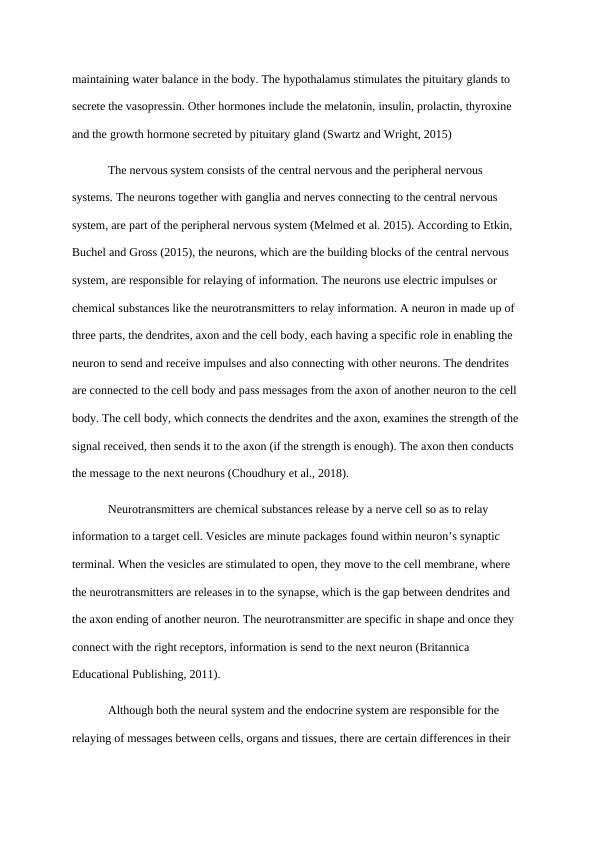The Endocrine System
Added on 2023-04-06
6 Pages1154 Words225 Views
Student name
Student No.
Unit
Title: The Endocrine System
Student No.
Unit
Title: The Endocrine System

The endocrine system together with the nervous system work to control and
coordinate balance in the body, homeostasis. The nervous system uses electrical impulses
while the endocrine system uses hormones (Valenzuela, Puglia and Zucca, 2011). Kaur and
Singh (2017) think that hormones are molecules that act as messengers and communicates to
the rest of the body through the blood stream. The hormones are responsible for initiating and
controlling the body mechanism. They have a great impact on growth and development of the
body, metabolism and sexual functions. Some hormones work fast to start or stop a body
process while others work over long time to achieve their functions.
The correct functioning of hormones is crucial for maintaining physical and emotional
fitness. There are different types of hormones in our bodies. Hormone oxytocin, also known
as the birth hormone regulates the adaptive behaviors of the central nervous system such as
sexual functioning patterns. This hormone is crucial in breast milk production and in the birth
process. It helps in contraction and relaxation os muscles (like the uterine muscles). Oxytocin
being a neurotransmitter, it is involved in paternal filial relationships, memory and learning
and in maternal attachment behaviour. Hypothalamus, a part in the brain, stimulates the
pituitary glands to secrete hormone oxytocin. Testosterone is a sex hormone produced in the
adrenal glands and is regulated by the pituitary gland. This hormone is responsible for typical
male characteristics such as development of sexual organs, height, hair and sperm production.
It is a vital hormone in reproduction as it is responsible for sperm production and regulation
of sex desires (Rushton and Cooley, 2009). Adrenaline is both a neurotransmitter and a
hormone. Adrenaline is secreted by the adrenal glands and metabolized by the liver. It is
responsible for triggering flight response. It is also responsible for increasing blood pressure
and dilation of pupils among other many effects. Estrogen is a female sex hormone produced
by the ovaries and the placenta in case of pregnant women. It has similar effects to those of
testosterone in men. The diuretic hormone, also called the vasopressin, is in charge of
coordinate balance in the body, homeostasis. The nervous system uses electrical impulses
while the endocrine system uses hormones (Valenzuela, Puglia and Zucca, 2011). Kaur and
Singh (2017) think that hormones are molecules that act as messengers and communicates to
the rest of the body through the blood stream. The hormones are responsible for initiating and
controlling the body mechanism. They have a great impact on growth and development of the
body, metabolism and sexual functions. Some hormones work fast to start or stop a body
process while others work over long time to achieve their functions.
The correct functioning of hormones is crucial for maintaining physical and emotional
fitness. There are different types of hormones in our bodies. Hormone oxytocin, also known
as the birth hormone regulates the adaptive behaviors of the central nervous system such as
sexual functioning patterns. This hormone is crucial in breast milk production and in the birth
process. It helps in contraction and relaxation os muscles (like the uterine muscles). Oxytocin
being a neurotransmitter, it is involved in paternal filial relationships, memory and learning
and in maternal attachment behaviour. Hypothalamus, a part in the brain, stimulates the
pituitary glands to secrete hormone oxytocin. Testosterone is a sex hormone produced in the
adrenal glands and is regulated by the pituitary gland. This hormone is responsible for typical
male characteristics such as development of sexual organs, height, hair and sperm production.
It is a vital hormone in reproduction as it is responsible for sperm production and regulation
of sex desires (Rushton and Cooley, 2009). Adrenaline is both a neurotransmitter and a
hormone. Adrenaline is secreted by the adrenal glands and metabolized by the liver. It is
responsible for triggering flight response. It is also responsible for increasing blood pressure
and dilation of pupils among other many effects. Estrogen is a female sex hormone produced
by the ovaries and the placenta in case of pregnant women. It has similar effects to those of
testosterone in men. The diuretic hormone, also called the vasopressin, is in charge of

maintaining water balance in the body. The hypothalamus stimulates the pituitary glands to
secrete the vasopressin. Other hormones include the melatonin, insulin, prolactin, thyroxine
and the growth hormone secreted by pituitary gland (Swartz and Wright, 2015)
The nervous system consists of the central nervous and the peripheral nervous
systems. The neurons together with ganglia and nerves connecting to the central nervous
system, are part of the peripheral nervous system (Melmed et al. 2015). According to Etkin,
Buchel and Gross (2015), the neurons, which are the building blocks of the central nervous
system, are responsible for relaying of information. The neurons use electric impulses or
chemical substances like the neurotransmitters to relay information. A neuron in made up of
three parts, the dendrites, axon and the cell body, each having a specific role in enabling the
neuron to send and receive impulses and also connecting with other neurons. The dendrites
are connected to the cell body and pass messages from the axon of another neuron to the cell
body. The cell body, which connects the dendrites and the axon, examines the strength of the
signal received, then sends it to the axon (if the strength is enough). The axon then conducts
the message to the next neurons (Choudhury et al., 2018).
Neurotransmitters are chemical substances release by a nerve cell so as to relay
information to a target cell. Vesicles are minute packages found within neuron’s synaptic
terminal. When the vesicles are stimulated to open, they move to the cell membrane, where
the neurotransmitters are releases in to the synapse, which is the gap between dendrites and
the axon ending of another neuron. The neurotransmitter are specific in shape and once they
connect with the right receptors, information is send to the next neuron (Britannica
Educational Publishing, 2011).
Although both the neural system and the endocrine system are responsible for the
relaying of messages between cells, organs and tissues, there are certain differences in their
secrete the vasopressin. Other hormones include the melatonin, insulin, prolactin, thyroxine
and the growth hormone secreted by pituitary gland (Swartz and Wright, 2015)
The nervous system consists of the central nervous and the peripheral nervous
systems. The neurons together with ganglia and nerves connecting to the central nervous
system, are part of the peripheral nervous system (Melmed et al. 2015). According to Etkin,
Buchel and Gross (2015), the neurons, which are the building blocks of the central nervous
system, are responsible for relaying of information. The neurons use electric impulses or
chemical substances like the neurotransmitters to relay information. A neuron in made up of
three parts, the dendrites, axon and the cell body, each having a specific role in enabling the
neuron to send and receive impulses and also connecting with other neurons. The dendrites
are connected to the cell body and pass messages from the axon of another neuron to the cell
body. The cell body, which connects the dendrites and the axon, examines the strength of the
signal received, then sends it to the axon (if the strength is enough). The axon then conducts
the message to the next neurons (Choudhury et al., 2018).
Neurotransmitters are chemical substances release by a nerve cell so as to relay
information to a target cell. Vesicles are minute packages found within neuron’s synaptic
terminal. When the vesicles are stimulated to open, they move to the cell membrane, where
the neurotransmitters are releases in to the synapse, which is the gap between dendrites and
the axon ending of another neuron. The neurotransmitter are specific in shape and once they
connect with the right receptors, information is send to the next neuron (Britannica
Educational Publishing, 2011).
Although both the neural system and the endocrine system are responsible for the
relaying of messages between cells, organs and tissues, there are certain differences in their

End of preview
Want to access all the pages? Upload your documents or become a member.
Related Documents
The Living Body: Components of a Reflex Arc, Endocrine Glands, Nervous and Endocrine System Coordination, Male and Female Reproductive Systemlg...
|10
|1680
|312
The Endocrine System: Functions of Hormones, Role of Blood, and Hormone Replacement Therapylg...
|6
|1651
|381
Nervous and Endocrine systems, and Homeostatic Mechanismslg...
|10
|2081
|397
The Endocrine System: Structure and Functionslg...
|9
|1463
|405
Key Components of Reflex Arc, Endocrine Glands and Reproductive Systemlg...
|10
|2015
|125
Nursing Practice Knowledge and Care: Endocrine, Renal and Respiratory Systemslg...
|6
|1715
|458
